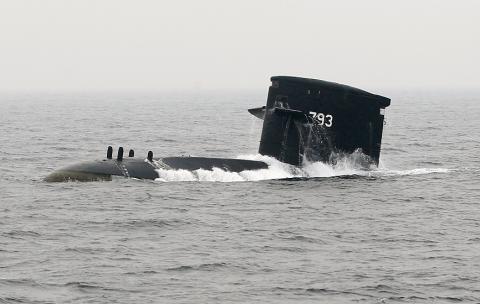The navy yesterday unveiled two refurbished minesweepers acquired from the US last year during a demonstration in waters off Greater Kaohsiung simulating a submarine intrusion.
A Lafayette-class frigate with media onboard, accompanied by two Chengkung-class frigates, a German-made minesweeper and two Osprey-class mine hunters headed into the Taiwan Strait to seek out an intruder submarine.
The mine hunters — MHC 1310 and 1311 — were obtained in August.

Photo: Reuters
Six Kuang Hua VI fast-attack missile boats, an S-2T Turbo Tracker anti-submarine aircraft and an S-70C helicopter, which dropped a sonobuoy to locate the enemy submarine, were also involved in the drill.
A navy Hai Lung submarine surfaced after the S-70 dropped a Mk46 torpedo.
It was the first time that the Osprey mine hunters had been on public display.
A number of vessels anchored at Tsuoying Naval Base, including some that participated in the exercise, showed that progress is being made in a NT$12 billion (US$406 million) program launched in May 2011 to outfit the Chengkung frigates, as well as the domestically made Ching Chiang-class patrol boats, with Hsiung Feng III supersonic anti-ship cruise missiles.
Four HF-3 launchers were seen on the two Chengkung-class frigates, PFG 1105 and PFG 1109, that took part in the exercise. In all, 120 HF-3s are to be added to the navy’s arsenal under the program.
Taiwan’s submarine chasing capabilities will be substantially enhanced after it receives 12 refurbished US P-3C Orion maritime aircraft to replace the aging S-2Ts, which were acquired in the 1980s.
Navy officials said the exercise highlighted the nation’s military preparedness and combat readiness ahead of the Lunar New Year.
A second day of exercises is planned for today at army and air force bases in Hualien.

ANOTHER EMERGES: The CWA yesterday said this year’s fourth storm of the typhoon season had formed in the South China Sea, but was not expected to affect Taiwan Tropical Storm Gaemi has intensified slightly as it heads toward Taiwan, where it is expected to affect the country in the coming days, the Central Weather Administration (CWA) said yesterday. As of 8am yesterday, the 120km-radius storm was 800km southeast of Oluanpi (鵝鑾鼻), Taiwan’s southernmost tip, moving at 9kph northwest, the agency said. A sea warning for Gaemi could be issued tonight at the earliest, it said, adding that the storm is projected to be closest to Taiwan on Wednesday or Thursday. Gaemi’s potential effect on Taiwan remains unclear, as that would depend on its direction, radius and intensity, forecasters said. Former Weather Forecast

As COVID-19 cases in Japan have been increasing for 10 consecutive weeks, people should get vaccinated before visiting the nation, the Centers for Disease Control (CDC) said. The centers reported 773 hospitalizations and 124 deaths related to COVID-19 in Taiwan last week. CDC Epidemic Intelligence Center Director Guo Hung-wei (郭宏偉) on Tuesday said the number of weekly COVID-19 cases reported in Japan has been increasing since mid-May and surpassed 55,000 cases from July 8 to July 14. The average number of COVID-19 patients at Japan’s healthcare facilities that week was also 1.39 times that of the week before and KP.3 is the dominant

The Chinese Communist Party’s (CCP) working group for Taiwan-related policies is likely to be upgraded to a committee-level body, a report commissioned by the Mainland Affairs Council (MAC) said. As Chinese President Xi Jinping (習近平) is increasingly likely to upgrade the CCP’s Central Leading Group for Taiwan Affairs, Taiwanese authorities should prepare by researching Xi and the CCP, the report said. At the third plenary session of the 20th Central Committee of the CCP, which ended on Thursday last week, the party set a target of 2029 for the completion of some tasks, meaning that Xi is likely preparing to

US-CHINA TRADE DISPUTE: Despite Beijing’s offer of preferential treatment, the lure of China has dimmed as Taiwanese and international investors move out Japan and the US have become the favored destinations for Taiwanese graduates as China’s attraction has waned over the years, the Ministry of Labor said. According to the ministry’s latest income and employment advisory published this month, 3,215 Taiwanese university graduates from the class of 2020 went to Japan, surpassing for the first time the 2,881 graduates who went to China. A total of 2,300 graduates from the class of 2021 went to the US, compared with the 2,262 who went to China, the document showed. The trend continued for the class of 2023, of whom 1,460 went to Japan, 1,334 went to